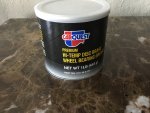I just installed GT 101’s toe link boot covers. Although they fit well I had issues getting the compression rings to stay on. The boots are a tight fit so I left them off. Anyway before and after pic. A fix folks might consider. I would imagine most GT’s by now have them deteriorated.
Toe link boot install
- Thread starter Art138
- Start date
You are using an out of date browser. It may not display this or other websites correctly.
You should upgrade or use an alternative browser.
You should upgrade or use an alternative browser.
I ordered the boots from GT101 too. Thanks for the info. I have procrastinated about getting them on. As a temporary fix I squirt the links with motorcycle chain lube, since it's designed to stay on the chain and repel water. I figure it will work pretty well here too. But I really should get a round tuit.
I changed mine in 2016 before a few days at Road Atlanta. I asked Rich Brooks about how they greased them and he said they just stuffed as much grease into them by hand as possible. I asked him if they ever considered using a grease needle and injecting all of the boots for the control arms, toe links, etc. He said they had never done it as they were worried about the boots developing a tear. I decided to try it on the replaceable toe link boots. After injecting grease into the boots I left the car on the lift for a few days until no more grease was coming out of the injection needle puncture then I wiped off any grease on the boot and cleaned the boot with heptane which is the solvent used in cleaning an inner tube or tire before patching. I also carefully cleaned the puncture itself with heptane and then placed one small drop of superglue over the puncture and left it fully cure for two or three days before taking the car off of the lift. After the three days at Road Atlanta the car went back up on the lift for oil change, brake service, etc. and when I checked the rear toe link boots they were full of grease, the drop of superglue had sealed the grease needle puncture and no grease leakage was apparent. This lead me to believe that all of the boots should be injected as they don't have much grease in them and we all know that currently ball joints are not replaceable and I don't want to replace my billet control arms. Consequently I performed the same procedure and injected every boot with synthetic grease and glued the puncture shut with super glue. After a year and a half and many more track days the boots are as good as new with no leakage of grease and obviously no tears in the boots. This was not a process to be hurried as all of the internal excess pressure from filling the boots must be relieved before cleaning and then gluing the puncture shut. Normally boots are just injected and left however my reason for gluing the puncture was to prevent a tear in a non replaceable boot such as in the control arms.
For boot "band aid's" Ive been using "Aquaseal urethane repair adhesive and sealant" I used this product 2 years ago on the LCA outter boots. As of last winter it held up (a year in service). I have not yet looked this year to see how it is holding up. Its flexible when cured. I found it classified as fishing waider repair.
https://www.amazon.com/Essentials-A...5151&sr=8-3&keywords=aquaseal+repair+adhesive
https://www.amazon.com/Essentials-A...5151&sr=8-3&keywords=aquaseal+repair+adhesive
https://www.amazon.com/gp/aw/d/B004...s=heptane&dpPl=1&dpID=41m7phdRGdL&ref=plSrch#Where does one obtain heptane? Is it similar to unobtainium?
Sent from my SM-G950U using Tapatalk
Just Google Bestine. That solvent is heptane. We use it to make repairs or modifications to vulcanized rudder diving dry suits.
HOOKED ON GT
GT Owner
I have to do (have all the boots) the toe links and the lower control arms when I do the Ohlins shocks (coming soon).
What synthetic grease did you use. Anything special?
Stu
What synthetic grease did you use. Anything special?
Stu




